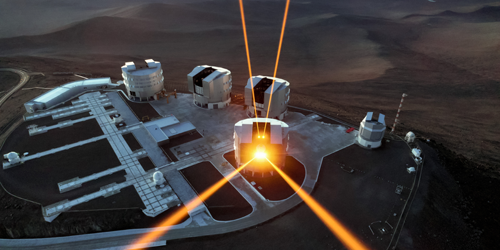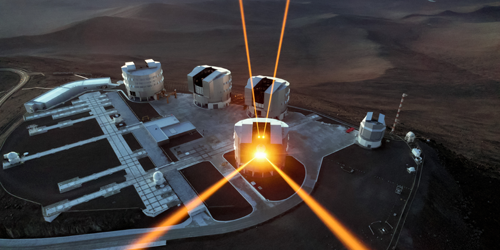Laser Stars for Astrophysical Calibrations
Earth’s atmosphere poses problems to telescopes on the ground, as air turbulence blurs images of the sky. This problem can be mitigated with the aid of artificial “guide stars”—point-like light sources created by laser beams that excite sodium atoms in Earth’s upper atmosphere. By observing these stars, astronomers can characterize and correct for atmospheric distortions. Now, a team led by Frédéric Vogt of the European Southern Observatory in Chile has demonstrated another surprising application: the light from laser-guide stars can be used to calibrate the wavelength of certain astronomical observations.
As the laser photons travel through the atmosphere, some of them get scattered by molecules through so-called Raman processes. In these processes, light excites rotational and vibrational modes of the molecules, thereby losing energy and undergoing a tiny wavelength shift depending on the energies of these states. In a previous study of the laser-guide system at the Very Large Telescope (VLT) in Chile (see 22 June 2017 Synopsis), the researchers showed that they could detect many wavelength-shifted light peaks, which were primarily due to Raman interactions with oxygen and nitrogen molecules in the air.
In the new work, the team used the same VLT laser-guide system to show that this series of scattering lines, whose wavelengths are accurately known, can be used to test the wavelength calibration of measurements by a spectrometer at the VLT called ESPRESSO. This instrument has two main goals: to study rocky exoplanets and to measure subtle wavelength shifts in atomic absorption lines from distant galaxies that could signal variations in fundamental constants. Their analysis shows that the Raman-line calibration technique could allow researchers to confirm the wavelength accuracy of ESPRESSO and other astronomical spectrometers.
This research is published in Physical Review Letters.
–Matteo Rini
Matteo Rini is the Deputy Editor of Physics.





